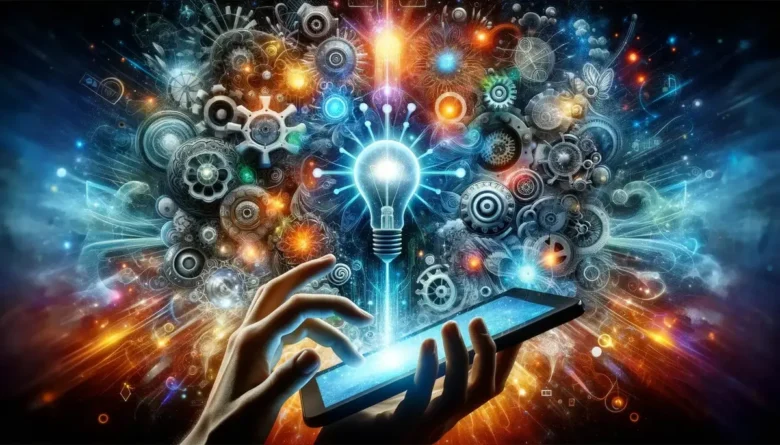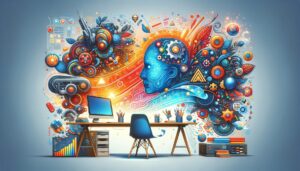Technology and creation have always had a dynamic relationship, but the connection between the two has never been closer or easier. With the proliferation of digital tools in the studio and at work, the human mind is poised to explore new and uncharted territories. This interaction has given us more ways to express ourselves and led to new ideas we could not have imagined before. Whether you are an artist, entrepreneur, teacher, or simply someone who likes to think, the importance of technology in fueling your imagination cannot be overstated.
In this article, we explore how technology can contribute to creative thinking and fuel it, transforming everyday inspiration into world-changing ideas. We discuss how new technologies are enabling new ideas, making creative tools more accessible, breaking through old limitations, and changing the way people think. Ultimately, you will gain a new understanding of how digital tools can help you be more creative and get answers to some frequently asked questions about this ever-changing field.
How Technology and Creativity Work Together to Improve Each Other:
Imagination and technology work well together because they both seek to solve problems and explore other possible solutions. In the past, every major advance in art or science was associated with a new tool or method. From the printing press to the camera and now to advanced software packages and artificial intelligence, technology has repeatedly changed what it means to make things. Artists no longer use canvases; they use tablets. Musicians create entire albums on computers, and writers use AI editing tools to experiment with different styles. Technology has thus become both a medium and a catalyst, allowing artists to rethink what is possible and to break down the barriers between disciplines.
Technology as an Art Form:
People often discover new ideas through new technologies, which they can use as tools and sources of inspiration. Virtual reality enables architects and storytellers to explore places beyond their imaginations. Filmmakers are using drones to capture images that conventional equipment can’t, and scientists are altering gene patterns to create art that people can feel. There are many opportunities in the digital world for those willing to look around. Online platforms connect creatives to global trends, break down barriers, and encourage the creation of entirely new styles. These touchpoints show that technology does more than just support creativity; it often stimulates and channels it in new ways.
Expand Access to Creative Tools:
Making creative tools accessible to more people is one of the most important changes of the digital age. Today, high-quality software is abundant for editing photos, making movies, and producing music that you can get for free or for a fraction of the price. Such software makes artistic expression accessible to virtually everyone, regardless of background or financial situation. Teenagers can record and edit a short video with just a smartphone, and aspiring musicians can share their songs with people around the world without having to go to a recording studio. This new cultural landscape encouraged a sense of shared ownership of art and invention, breaking down the barriers that previously confined creative people to an elite group.
Let Your Creative Expressions Sound Louder:
Technology has broken down traditional barriers, allowing artists to easily switch between formats and styles. Visual artists are enhancing real-world projects with augmented reality, blurring the boundaries between digital and tangible experiences. When writers aren’t limited to a set number of pages, they’re experimenting with interactive stories and multimedia formats. Artificial intelligence and musicians are working together to create entirely new sounds, and motion capture software is helping choreographers create previously unimaginable shows. The perfect marriage of technology and art has given people more artistic possibilities, allowing them to express themselves in ways that were impossible a decade ago.
Community and Collaboration:
Digital platforms are breaking down the barriers of distance and culture, enabling vast social and collaborative networks. Technology is allowing people to collaborate on projects, whether it’s developing an app with someone abroad or expanding an open-source music collection. Online forums, art collectives, and social media groups provide artists with instant feedback, while the ability to share tools has made working from home the norm. This global creative village is full of diverse perspectives, allowing people to come up with new ideas that no individual or culture could have come up with alone. When technology enables and facilitates collaboration, it becomes a weapon.
How to Overcome a Creative Block:
Even the most creative people struggle sometimes, but technology gives us the tools to overcome these challenges. When inspiration wanes, an AI suggestion engine can suggest story ideas, musical chords, or color schemes. Speech-to-text or keyword generators are time-saving tools that can help you get projects moving again and remember the process. Digital mind-mapping apps, shared whiteboards, and online thinking spaces can help people generate new ideas faster, unblock them, and get back on track. Ultimately, these tools show that technology is not just a way to make things but also an important part of coming up with creative solutions to problems.
What Can We Do with AI: Is It a Creative Partner or a Threat?
Artificial intelligence is often at the center of debates about how to shape the future. Some fear that the growing power of artificial intelligence will make humans less relevant and therefore less authentic. But as it stands, artificial intelligence is more of a partner than a competitor. It helps by automating boring tasks, generating concepts or options for evaluation, and retrieving useful information from a vast database. Generative algorithms help artists and designers explore ideas they might not have thought of themselves. AI does this by taking over boring tasks and stimulating creativity, allowing creators to focus on what makes their vision special. Yet careful collaboration is needed to ensure that human creativity remains at the forefront.
The Responsibility of Creativity in the Digital Age:
Combining technology and imagination effectively combines multiple forces. The ease with which other people’s work can be copied, remixed, or modified in the digital space makes it difficult to establish ownership and validity. Inspiration, intellectual property rights, cultural awareness, and truth-telling are all issues that creators must consider. Artificial intelligence and other technologies can create biases or produce content that crosses ethical lines. It is therefore important for individuals and companies to take a responsible approach, set rules, and talk openly about the ethics of digital creation. Now more than ever, it is crucial to maintain an open-minded mindset, acknowledge the contributions of others, and appreciate both the tools and the creators.
What’s Next for Creativity?
In the future, we expect technology to make people more creative rather than take away their creativity. Wearable technology, augmented reality, and brain-computer connections are improving, forcing machines and humans to work more closely together. These new technologies promise to make everything more accessible and give people of all abilities the opportunity to express themselves to their fullest potential. Industry leaders foresee a future where the creativity of AI will support, not replace, manufacturers. Instead, AI will inject new ideas into manufacturers and act as a second brain. The creative process won’t disappear; rather, it will grow in size, depth, and functionality as both the tools and we change.
Empowering People to Be Creative in New Ways:
Today, technology and creativity are more closely intertwined than ever, reinforcing and transforming each other. Digital innovation makes it easier for everyone to come up with and realize new ideas. It enables us to share ideas with people around the world, giving us more speed and freedom than ever. While challenges remain, particularly around protecting ethics and authenticity, the potential for creative fulfillment is enormous. If you want to be more creative, now is the time to try new tools, find multiple partners, and experiment fearlessly. Technology enables people to be more creative than ever .
FAQs:
1. How can technology make you more creative?
Technology gives us new platforms, tools, and ways of doing things. It also inspires us to try new things and come up with creative ideas that we might not have thought of otherwise.
2. Can anyone be creative with technology?
Absolutely. Today’s technology has made artistic tools accessible to almost everyone, allowing people of all levels to share their ideas.
3. Will artificial intelligence and technology diminish human creativity?
Artificial intelligence does not replace humans; instead, it works alongside them. It saves time by automating tedious tasks and giving us new ideas, but humans are still needed to realize the big ideas and think creatively.
4. What do you think is the most important ethical issue in digital creativity?
Issues that need to be addressed include protecting intellectual property rights, ensuring the authenticity of content, combating digital intolerance, and respecting the work of other artists.
5. What does the future of talent and technology look like?
The sky seems clear. As technology advances, more powerful and user-friendly creative tools will emerge, allowing more people to express themselves creatively.




